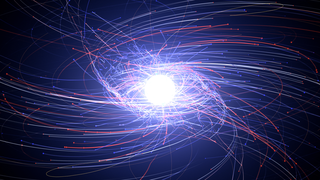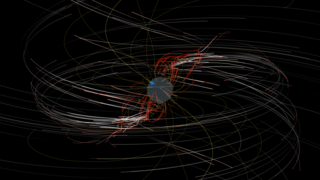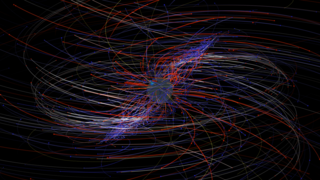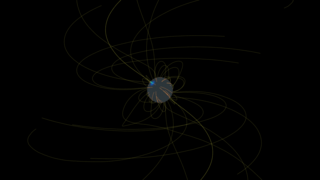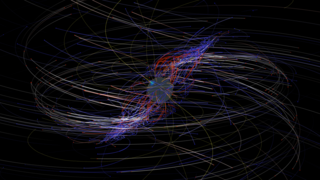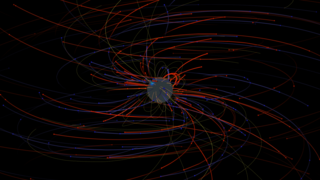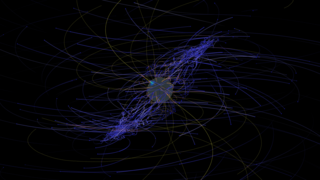Universe
ID: 4637
Scientists studying what amounts to a computer-simulated “pulsar in a box” are gaining a more detailed understanding of the complex, high-energy environment around spinning neutron stars, also called pulsars. The model traces the paths of charged particles in magnetic and electric fields near the neutron star, revealing behaviors that may help explain how pulsars emit gamma-ray and radio pulses with ultraprecise timing.
A pulsar is the crushed core of a massive star that exploded as a supernova. The core is so compressed that more mass than the Sun's squeezes into a ball no wider than Manhattan Island in New York City. This process also revvs up its rotation and strengthens its magnetic and electric fields.
This visualization illustrates what the pulsar magnetic field would look like without the influence of the charged particles around it. The charged particles create currents which alter the magnetic field.
Pulsars and their Magnetic Field - Vacuum solution
A pulsar is the crushed core of a massive star that exploded as a supernova. The core is so compressed that more mass than the Sun's squeezes into a ball no wider than Manhattan Island in New York City. This process also revvs up its rotation and strengthens its magnetic and electric fields.
This visualization illustrates what the pulsar magnetic field would look like without the influence of the charged particles around it. The charged particles create currents which alter the magnetic field.
Used Elsewhere In
Related
Visualization Credits
Tom Bridgman (Global Science and Technology, Inc.): Lead Data Visualizer
Scott Wiessinger (USRA): Lead Producer
Francis Reddy (University of Maryland College Park): Writer
Gabriele Brambilla (University of Milan): Lead Scientist
Alice Harding (NASA/GSFC): Scientist
Scott Wiessinger (USRA): Lead Producer
Francis Reddy (University of Maryland College Park): Writer
Gabriele Brambilla (University of Milan): Lead Scientist
Alice Harding (NASA/GSFC): Scientist
Please give credit for this item to:
NASA's Scientific Visualization Studio
NASA's Scientific Visualization Studio
Short URL to share this page:
https://svs.gsfc.nasa.gov/4637
Data Used:
Note: While we identify the data sets used in these visualizations, we do not store any further details nor the data sets themselves on our site.
This item is part of these series:
Astrophysics Visualizations
Astrophysics Simulations
Pulsar Current Sheets
Keywords:
SVS >> Magnetic Fields
SVS >> Neutron Star
SVS >> Hyperwall
SVS >> Astrophysics
SVS >> Pulsar
NASA Science >> Universe
https://svs.gsfc.nasa.gov/4637
Data Used:
Brambilla Pulsar Model
ModelThis item is part of these series:
Astrophysics Visualizations
Astrophysics Simulations
Pulsar Current Sheets
Keywords:
SVS >> Magnetic Fields
SVS >> Neutron Star
SVS >> Hyperwall
SVS >> Astrophysics
SVS >> Pulsar
NASA Science >> Universe
